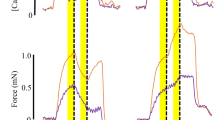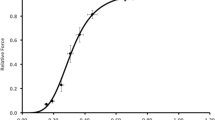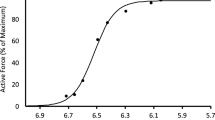Summary
-
1.
Contraction of smooth adductor muscles (SmA) in the brachiopod,Laqueus californicus, is followed by very slow relaxation (R 1/2=3 min). The period during which the cross-bridges are in the active state extends from the time of activation to a short time after peak tension is reached. The delayed relaxation phase represents tension maintenance in the absence of the active state.
-
2.
The contraction characteristics of these muscles were compared to those during the catch contractions of mollusc adductor muscles. The immediate elasticity of brachiopod SmA, defined as the change in tension in response to quick length changes, is the same during the contraction and relaxation phases. The immediate elasticity of mollusc catch muscles is greater during the tonic relaxation (catch) than the active contraction phase (Pfitzer and Rüegg 1982).
-
3.
When exposed to CO2, the SmA, whether relaxed or during contraction, enter a reversible rigor-like state of stretch resistance. The immediate elastic modulus during these conditions was the same as during normal contractions.
-
4.
The results indicate that the same physical linkages, probably actomyosin cross-bridges, are responsible for all phases of the contraction/relaxation cycle and also during CO2 induced rigor-like stiffness.
Similar content being viewed by others
Abbreviations
- ABRM :
-
anterior byssus retractor muscle
- ACh :
-
acetylcholine
- ASW :
-
artificial sea water
- EMG :
-
electromyogram
- ΔL :
-
step length change
- L o :
-
resting fiber length
- ΔP :
-
recovery of tension 6 sec after length change
- ΔP/ΔL :
-
static elastic modulus
- QR :
-
quick release of tension by step length change
- R 1/2 :
-
half relaxation time
- SmA :
-
smooth adductor muscle
- T o :
-
tension immediately preceding length change
- T 1 :
-
immediate change in tension following step length change
- T 1/ΔL :
-
immediate elastic modulus
References
Achazi RK (1979) Phosphorylation of molluscan paramyosin. Pflügers Arch 379:197–201
Achazi RK (1982) Catch muscle. In: Twarog BM, Levine RJC, Dewey MM (eds) Basic Biology of Muscles: A Comparative Approach. Raven Press, New York, pp 291–308
Aksoy MO, Mras S, Kamm KE, Murphy RA (1983) Ca2+, cAMP, and changes in myosin phosphorylation during contraction of smooth muscle. Am J Physiol 245:C255-C270
Baguet F, Gillis JM (1968) Energy cost of tonic contraction in a lamellibranch catch muscle. J Physiol 198:127–143
Caldwell PC (1958) Studies on the internal pH of large muscle and nerve fibres. J Physiol 142:22–62
Chatterjee M, Murphy RA (1983) Calcium-dependent stress maintenance without myosin phosphorylation in skinned smooth muscle. Science 221:464–466
Dillon PF, Murphy RA (1982) Tonic force maintenance with reduced shortening velocity in arterial smooth muscle. Am J Physiol 242:C102-C108
Dillon PF, Aksoy MO, Driska SP, Murphy RA (1981) Myosin phosphorylation and the cross-bridge cycle in arterial smooth muscle. Science 221:495–497
Edman KAP, Mattiazzi R (1981) Effects of fatigue and altered pH on isometric force and velocity of shortening at zero load in frog muscle fibres. Muscle Res Cell Motil 2:321–334
Eshleman WP, Wilkens, JL, Cavey MJ (1982) Electrophoretic and electron microscopic examination of the adductor and diductor muscles of an articulate brachiopod,Terebratalia transversa. Can J Zool 60:550–559
Gilloteaux J, Baguet F (1977) Contractile filaments organization in functional states of the anterior byssus retractor muscle (ABRM) ofMytilus edulis L. Cytobiologie 15:192–220
Gosline JM, Shadwick RE (1983) Molluscan collagen and its mechanical organization and squid mantle. In: Hochachka PW (ed) The Mollusca, vol I. Metabolic Biochemistry and Molecular Biomechanics. Academic Press, New York, pp 371–398
Johnson WH, Twarog BM (1960) The basis of prolonged contractions in molluscan muscles. J Gen Physiol 43:941–960
Johnson WH, Kahn JS, Szent-Györgyi AG (1959) Paramyosin and contraction of ‘catch muscles’. Science 130:160–161
Levine RJC, Elfvin M, Dewey MM, Walcott B (1976) Paramyosin in invertebrate muscles. II. Content in relation to structure and function. J Cell Biol 71:273–279
Lowy J, Millman BM (1963) The contractile mechanism of the anterior byssus retractor muscle ofMytilus edulis. Phil Trans B 246:106–148
Pfitzer G, Rüegg JC (1982) Molluscan catch muscle: regulation and mechanics in living and skinned anterior byssus retractor muscle ofMytilus edulis. J Comp Physiol 147:137–142
Rudwick MJS (1970) Living and fossil Brachiopods. Hutchinson University Library. London
Rüegg JC (1961) The proteins associated with contraction in lamellibranch ‘catch’ muscle. Proc R Soc Lond B 154:209–223
Rüegg JC (1964) Tropomyosin paramyosin system and ‘prolonged contraction’ in a molluscan smooth muscle. Proc R Soc Lond B 160:536–542
Rüegg JC (1971) Smooth muscle tone. Physiol Rev 51:201–248
Singer HA, Kamm KE, Murphy RA (1986) Estimates of activation in arterial smooth muscle. Am J Physiol 251:C465-C473
Smith SA, Thayer CW, Brett CE (1985) Predation in the paleozoic: gastropod-like drillholes in devonian brachiopods. Science 230:1033–1035
Tomeyasu T, Sugi H (1976) The series elastic component and the force-velocity relation in the anterior byssal retractor muscle ofMytilus edulis during active and catch contractions. J Exp Biol 64:497–510
Thayer CW (1985) Brachiopods versus mussels: competition, predation, and palatability. Science 228:1527–1528
Twarog BM (1976) Aspects of smooth muscle function in molluscan catch muscle. Physiol Rev 56:829–838
Wilkens LA (1972) Electrophysiological studies on the heart of the bivalve molluse,Modiolus demissus. J Exp Biol 56:273–291
Wilkens JL (1978a) Adductor muscles of brachiopods: activation and contraction. Can J Zool 56:315–323
Wilkens JL (1978b) Diductor muscles of brachiopods: activation and very slow contraction. Can J Zool 56:324–332
Woledge RG, Curtin NA, Homsher E (1985) Energetic aspects of muscle contraction. Monogr Physiol Soc No 41. Academic Press, New York, pp 27–117
Zar JH (1984) Biostatistical analysis, 2nd edn. Prentice Hall, Englewood Cliffs, NJ, pp 292–302
Author information
Authors and Affiliations
Rights and permissions
About this article
Cite this article
Wilkens, J.L. Tonic force maintenance after decay of active state in brachiopod smooth adductor muscle. J Comp Physiol B 157, 651–658 (1987). https://doi.org/10.1007/BF00700986
Accepted:
Issue Date:
DOI: https://doi.org/10.1007/BF00700986




